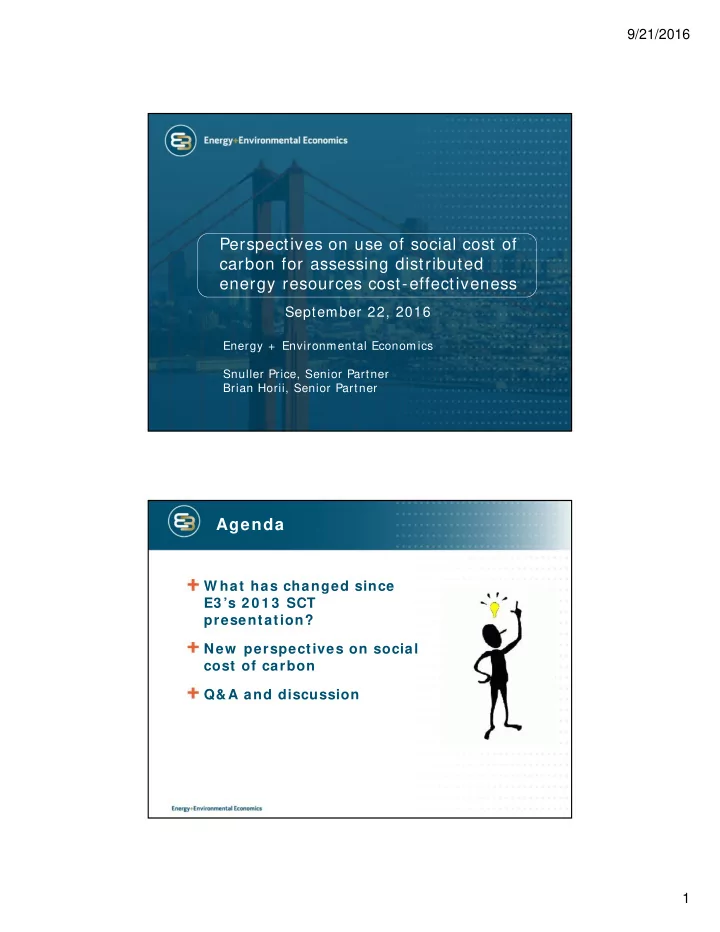

9/21/2016 Perspectives on use of social cost of carbon for assessing distributed energy resources cost-effectiveness September 22, 2016 Energy + Environmental Economics Snuller Price, Senior Partner Brian Horii, Senior Partner Agenda W hat has changed since E3 ’s 2 0 1 3 SCT presentation? New perspectives on social cost of carbon Q&A and discussion 1
9/21/2016 Recap of 2 0 1 3 Societal Cost Test w orkshop presentation by E3 An initial discussion of the societal cost test presented in 2 0 1 3 by Brian Horii and Jim W illiam s Study assessed w hat an SCT w ould look like Defines the com ponents that w ould need to be done to com pute an SCT consistent w ith the SPM • Key elements; social discount rate, non-energy benefits Social discount rate • Cites reasonable ranges (broadly) and literature Non-energy benefits focused on air em issions • Value of GHG emissions reductions • Value of criteria emissions reductions 3 W hat has changed since? Significantly increased focus on GHG em issions reductions in the long term through 2 0 5 0 • SB32 sets 2030 target of 40% below 1990 ARB m andate to consider societal costs in GHG regulations ( AB 1 9 7 , 2 0 1 6 ) Significantly m ore pressure to increase distributed energy resource ( DER) achievem ents • SB350 calls for doubling of energy efficiency, 50% RPS, and an integrated planning framework for least cost reductions Significantly low er energy prices • Led by low natural gas prices from increased supply • Low gasoline and fossil fuel prices from increased supply 4 2
9/21/2016 How to value reduced em issions? Tw o m ain approaches, dam age cost and com pliance cost w hich provide a range Damage cost $/tonne Includes cost to health, reduced agriculture, productivity, sea level rise Compliance cost Net cost of reducing a tonne of GHG emissions 5 Dam age function vs. m arginal cost of GHG abatem ent approaches From our perspective, the dam age function is appropriate for assessing the overall level of GHG reductions. Appropriately the ARB m andate. • Higher value, sets the overall level of stringency GHG abatem ent cost is appropriate in an I RP Straw proposal planning fram ew ork to evaluate the least net cost portfolio • e.g., is energy efficiency a lower cost way to reduce GHG emissions than my alternative approach? W hich cost test? • Seems appropriate to include avoided GHG measure net costs as a benefit of EE in a modified TRC and/ or an SCT • In other cost tests, appropriate to include avoided net costs to utility ratepayers (PAC, RIM) 6 3
9/21/2016 How m ight this be im plem ented? Sets overall GHG reduction plan with electricity and pipeline gas sector California’s Scoping targets, along with fuel switching Plan Update (electrification and pipeline gas) Refines electricity sector plan to hit CPUC IRP for comparable goals consistent with 40% Electricity Sector reduction at least cost, identifies marginal abatement opportunities Includes marginal abatement cost of Cost-effectiveness of alternative GHG reductions in cost- DER measures effectiveness assessment. In the near term, use a proxy analysis of marginal abatement cost if IRP is not yet completed 7 Challenges w ith m arginal GHG abatem ent approach ( 1 A) Problem 1 : How to estim ate the avoided cost of the alternative GHG reduction opportunity? Sub-problem 1 A: W hat scope of GHG reduction opportunities to consider? • Electricity Sector Only Scope • Pros: More certain cost, single regulated LSE for trade-offs • Cons: Not necessary least cost Straw proposal • CPUC jurisdictional Scope • Pros: More certain cost, one coordinated analysis across CPUC • Cons: Not necessarily least cost for society • Economy-wide Scope • Pros: Theoretically least cost approach • Cons: Multi-agency, cost uncertainty, difficult analysis 8 4
9/21/2016 Challenges w ith m arginal GHG abatem ent approach ( 1 B) Problem 1 : How to estim ate the avoided cost of the alternative GHG reduction opportunity? Sub-problem 1 B: How to calculate the cost of the avoided GHG m itigation m easure? • Two approaches are available, nearer and longer term • Best approach (longer term) • Use information from the CPUC I RP (and natural gas planning for CPUC jurisdictional scope) to calculate the net cost of the best other alternative in a marginal abatement cost calculation • Easier approach (shorter term) • Pick a proxy measure and compute the net marginal abatement cost of that measure • e.g., utility scale solar, electric vehicle, other measure 9 Challenges w ith approach ( 2 ) Problem 2 : How to calculate the m arginal abatem ent cost of alternative com pliance m easure? • This is not as easy as it might seem and requires many assumptions that can change the answer significantly Cost relative to a reference case Marginal abatement cost of alternative compliance measure Emissions relative to a reference case Requires Reference case definition Long term marginal emissions rates of reference case Vintage, lifetime, and annualization assumptions Forecast assumptions (energy, fuel, technology cost and performance) 10 5
9/21/2016 Discussion and Q&A Are w e right to think of the DER cost-effectiveness fram ew ork in coordination w ith the I RP process? I s the proposed m itigation cost as avoided alternative GHG com pliance cost appropriate as opposed to dam age estim ates of GHG em issions? W hat are the strengths and w eaknesses of the suggested CPUC-jurisdictional scope of the m arginal GHG abatem ent approach ? Other discussion topics 11 Contact I nform ation Snuller Price, Senior Partner (415)391-5100 snuller@ethree.com Brian Horii, Senior Partner (415)391-5100 brian@ethree.com 6
Recommend
More recommend